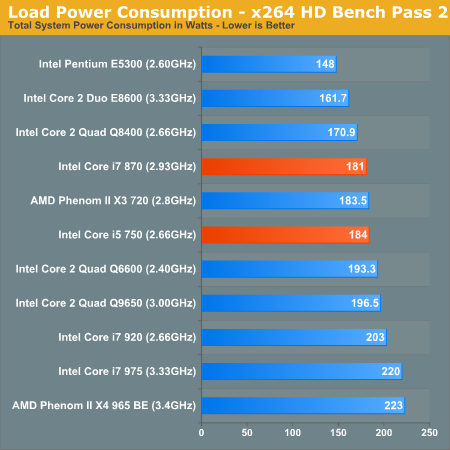Intel's Core i7 870 & i5 750, Lynnfield: Harder, Better, Faster Stronger
by Anand Lal Shimpi on September 8, 2009 12:00 AM EST- Posted in
- CPUs
Power Consumption
If you'll remember back to last year's Nehalem coverage I made a point to mention that the Nehalem architecture, thanks to its PCU and power gate transistors, was the most power efficient of the high end options. The lower the TDP, the more important power efficiency is and thus it's no surprise to see Lynnfield truly impress when it comes to power consumption:

At idle the Core i5 and Core i7 870 use less power than any other processor we've ever tested. Note that these idle power figures include an idling GeForce GTX 280. With a lower power graphics card, you could easily get to idle power consumption around 60W. Once we start seeing on-package GPUs, total system power consumption should drop even further.

Under load the Core i5 and Core i7 870 continue to impress. They both draw less power than a Q6600 or a Q9650, all the while outperforming the two. Power consumption is also noticeably lower than Bloomfield.
These things are fast and smart with power. Just wait until Nehalem goes below 65W...










343 Comments
View All Comments
yacoub - Tuesday, September 8, 2009 - link
lol, what a stupid comment. yes it's "cheating" to benchmark the processor the way it comes out of the box, which also happens to be how it is used in the real world environment.Voo - Tuesday, September 8, 2009 - link
Well there are many users who don't bother with overclocking so the tests aren't "illegal" or anything.But I tend to agree that most users who would be interested in buying an i7 920 or i7 860 would overclock it, so turbo mode wouldn't help at all, as we see with the OC results.
I'm curious if PCI-e on die is the only problem and if we'll see new chips who benefit from turbo mode even when overclocked. After all the principle behind turbo mode doesn't change if you overclock, does it?
james jwb - Tuesday, September 8, 2009 - link
IF that's true, i'm not at all happy with this review. But i'll wait for someone else to confirm this for obvious reasons... anand, confirm!Voo - Tuesday, September 8, 2009 - link
You read the text, didn't you? It was mentioned several times..james jwb - Tuesday, September 8, 2009 - link
i don't have time to read through all of it right now, was just flicking through and immeditaly thought to ask the question. I will read it fully later on, though.Hence why i asked the question. You say "it", as in which way, benches had turbo, benches didn't?
snakeoil - Tuesday, September 8, 2009 - link
yes again, turbo was on for all the benchmarks which is illegal and biased.maxxcool - Tuesday, September 8, 2009 - link
yes, the federal government says making a feature that makes your product better is legal.JarredWalton - Tuesday, September 8, 2009 - link
Illegal and biased? Yes, Intel is illegally making their CPUs run better at all workloads for normal users that don't overclock. Someone should arrest them! What would be biased is to test these CPUs in a fashion that artificially limits performance. Sure, it would be nice to see performance compared with and without Turbo enabled, but generally there's not enough time to run every potentially interesting test scenario.snakeoil - Tuesday, September 8, 2009 - link
there you go, finally you said it.all the benchmarks have at least 600 mhz over the processor's stock speed.
that is outrageous, then if you want to compare the result with phenom 2 you have to overclock phenom 2 at least 600 mhz over stock speed.
just to be fair
Anand Lal Shimpi - Tuesday, September 8, 2009 - link
The processor's stock speed is variable according to the workload it's running, that's what turbo mode does. AMD will enable similar functionality in 2011. This is the out-of-box performance of Lynnfield. Turbo mode is a feature of the processor as it has been since the mobile Penryn days (and more recently Nehalem). There's no reason to disable it as no end user would, unless you want to make Intel look worse for some reason.We also ran Turbo on vs. off numbers in the review: http://anandtech.com/cpuchipsets/showdoc.aspx?i=36...">http://anandtech.com/cpuchipsets/showdoc.aspx?i=36...
Take care,
Anand